|
Due to my busy schedule today, I’m squeezing in a quick post about Masi Agricola Spa in the Valpolicella Classico region (Veneto). I attended a wine tasting this past September where I sampled a few vintages of their Amarone. I think my post about it is worth sharing again. 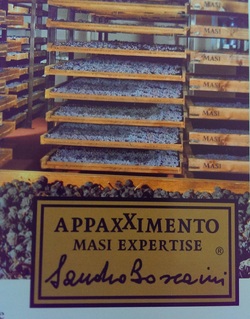 “I made my way to Veneto, where Tony Apostolakos, the U.S. Director of Masi Agricola was waiting to guide me through a tasting of Amarone. It is interesting to note that Sandro Boscaini, the owner of Masi, is referred to as “ Mr. Amarone” due to the unique crafting of his wines. He uses the appassimento method to concentrate aromas and flavors in wine. The Appaxximento symbol can be found on his labels guaranteeing the authenticity and quality of Masi Wine. I’ll highlight a few of the wines I tasted. The 2011 Costasera Amarone was full-bodied with cherry, plum and spices. The 2008 Vaio Armaron Amarone, aged in cherry wood casks for four months, was amazing. The aroma and flavor of cherries, spices and fruit lingered on the palate. Before I departed I was treated to a taste of 1999 Amarone della Valpolicella Classico. It had a beautiful bouquet of fruit and earth, with dark fruit and spice on the palate." 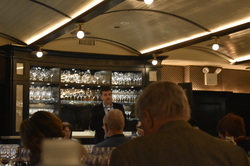 Raffaele Boscaini Raffaele Boscaini On Tuesday, at the Grandi Marchi Seminar, Sandro Boscaini’s son, Raffaele led us through a guided tasting of 2009 Riserva di Costasera. It is made with 70% Corvina, 15% Rondinella, 10% Oseleta and 5% Molinara grapes. Oak Maturation is 38-40 months with 6 months in the bottle. The color was deep ruby with aromas of cherry, plum and a touch of earth. The palate offered rich black cherry, spice and a hint of pepper. It was elegant and full-bodied with smooth tannins. Alcohol 15.5%. I will definitely add this wine to my collection. http://www.masi.it Happy Thursday!
Cheers! Penina  On Tuesday I attended The Grandi Marchi Experience in NYC, a guided tasting of Italy’s top terroirs. The event was held at Del Posto, another amazing creation of Mario Batali located in the now trendy meatpacking district. Gloria Maoroti Frazee, the Director of Video & Education, Wine Spectator, moderated the event. Not only did we taste the wines, but also had the pleasure of hearing from the principles of each winery as we swirled and sipped. Each spokesperson had a wonderful story to tell. We heard about their fathers, grandfathers and great-grandfathers who’s input helped to make the wines what they are today. The Institute of Fine Italian Wines-Premium brands is comprised of nineteen important Italian wineries with the objective to promote culture and commercialism of high end Italian wine to world markets. The wineries are defined by high standards of product and brand image at national and international levels.  Of the nineteen wineries that make up the institute, fifteen wineries were present yesterday. We tasted 15 wines from Lombardy, Tuscany, Marches, Piedmont, Sardinia, Sicily, Campania, Puglia, Umbria and Veneto. We started with a refreshing 2006 Cuvée Annamarie Clementi and ended with a 2008 Ben Ryé Passito di Pantelleria D.O.C Limited Edition dessert wine. In between we tasted two more whites and eleven reds from producers such as Gaja, Tenuta San Guido, Antinori, Masi, Rivera and Pio Cesare. I will elaborate on some of the wines that I tasted in tomorrow’s post.
Have a great Wednesday! Cheers! Penina 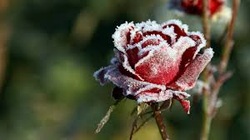 I woke up Monday morning to see frost on my outdoor plants. And, it snowed for a few minutes on Sunday! I guess winter is just around the corner and perhaps it’s time to dust off the skis and snowshoes. It’s also time to start thinking about bold wines to go with those hearty winter entrées. I have several reds that I’m looking forward to opening over the next few months. However, I’m still going to keep a few whites in my refrigerator because you just never know when the mood will strike! 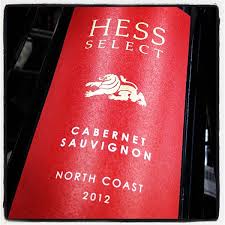 My friend and I dined at a lovely French restaurant last evening. To celebrate the “cold” weather, we ordered a bottle of 2012 Hess Select Cabernet Sauvignon, North Coast. The color was crimson with red fruit and spice aromas. On the palate: dark fruits, plum, anise, spice and a hint of vanilla. It was medium bodied with a jammy finish and paired well with the wild mushroom ravioli entrée. http://www.hesscollection.com I’m off to a wine event.
Happy Tuesday! Cheers! Penina  The weekend was filled with fun activity. Between cooking, attending an October Festival and meeting up with old and dear friends, I’m ready for a quiet Sunday. However, that’s not going to happen. I’m off and running soon! 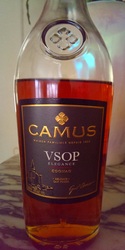 After a very long day, I was ready to curl up and watch the Mets vs. Cubs game last night. A phone call and a visitor changed all that. The game went on “mute” and the cognac came out. We had lots to chat about as we sipped on Camus VSOP. I have reviewed this cognac a few times. You can find the review in archives. My wine commentary for the day will have to wait until tomorrow. I’m grabbing one of my artwear shawls and heading out into this brisk day.
Happy Sunday! Cheers! Penina  It was with much anticipation that we all gathered around the television last evening to watch the fifth and final game of the National League Division series with the Mets vs. Dodgers. Finger food was served with many choices to be had in the drink department. I was tempted to have vodka, but the bottle of 2010 Domaine Eden Cabernet Sauvignon was beckoning to me. 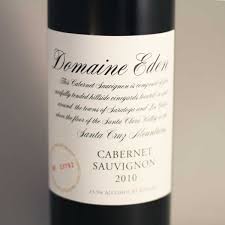 Mount Eden Vineyards is in the Santa Cruz Mountain Appellation. It was founded in 1945 and recognized as one of the “original” boutique California wineries. In 2007, they acquired an additional 55-acre wine estate in the Saratoga foothills that they named Domaine Eden. The Domaine Eden 2010 is 75% Cabernet Sauvignon, 14% Merlot, 6% Cabernet Franc, 4% Petit Verdot and 1% Malbec. The cherry red color invited aromas of dark fruit, especially plum and cherry. There was a subtle earthiness to it that carried over to the palate. It was rich with dark fruit, but not overbearing, allowing more “musk” to come through. Hints of anise and spice were present on the finish. The tannins were medium. This is a wine I could drink all winter long! http://www.mounteden.com  As you all know by now, the Mets won last night. And now they will face the Cubs for the NLCS title. Good luck, Mets! Have a great Friday! Cheers! Penina As much as I would like to discuss the wonderful wine that I had last evening, I will save it for another post. As promised, I’d like to continue my exploration of Portuguese wines.  The Vinho Verde region stretches across the northwest of Portugal which includes nine sub-regions. The popular Alvarinho wines are a specialty of the sub regions Moncao and Melgaco in the northern part of the Vinho Verde region. Lima Cavado and Ave sub-regions are to the south where the main grapes are Loureiro, Arinto and Trajadura.  Quinta da Lixa is an award winning, family run company owned by the Meireles family. It is located in the Sousa sub-region of the Vinho Verde region. Their table was filled with colorful and enticing wine bottles. The Pouco Comum 2014 is 100% Alvarinho. It had floral and fruity aromas with citrus, floral and tropical fruit notes on the palate. It was crisp with a long finish. The Anjos de Portugal 2014 Rosé was quite lively and made with Touriga Nacional and Espadeiro grapes. It was fruity with hints of grapefruit and melon. The Aromas das Castas 2014 is made with Alvarinho and Trajadura grapes. These grapes are considered “two of the noblest “ grape varieties in the Vinho Verde region. The dominant flavor was peach, but hints of pear and herbs came through. It was quite refreshing.  Alexandre Relvas Alexandre Relvas My last stop for today is back in the Alentejo region where I met Alexandre Relvas, of Casa Agricola Alexandre Relvas. He acquired the winery in 1997. It is situated in the municipality of Redondo. In addition to producing around 3 million bottles of wine a year, the owners are dedicated to breeding and conservation of local species. They also breed Merino sheep and sell the wool, which perked my interest as a knitter. Alexandre started me off with a taste of Ciconia Touriga Nacional 2014. This ruby colored wine had intense aromas of dark fruit, earth and spice. The palate offered dark berry, spice and a hint of truffle. It was very smooth with soft tannins. The next pour was Ciconia Reserva Tinto 2013. This red blend of Aragonez, Syrah and Touriga Nacional was filled with ripe berry, spices and medium tannins. It had a richness to it that will certainly improve with age. Although I have to catch up with other wines/countries that I have tasted recently, I will return to Portugal to give you my spin on their wines.
Have a great Thursday! Cheers! Penina 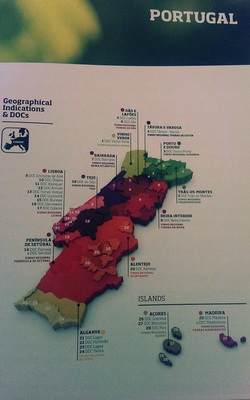 Portugal is located in the Southwest corner of Europe in the Iberian Peninsula. It is the westernmost country of Europe and surrounded by Spain to the North and East and the Atlantic Ocean to the South and West. What makes Portugal so unusual with regards to wine is that it boasts a remarkable number of grape varieties that cannot be found anywhere else in the world. In fact, many of the Portuguese grape varieties are restricted to the national territory. There are 250 indigenous grape varieties officially registered. The Alvarinho, Baga and Touriga Nacional grapes are probably the most widely known by name. Portugal is divided into fourteen Regional Wine areas. Each region has a unique geography and climate, influencing the production of the grapes. I had an opportunity to taste some very interesting wines from these regions at the Wines of Portugal event at the City Winery in New York. Most of the wines I tasted were blended, using several national grape varieties, as is their tradition to combine grape varieties rather than use 100% grape. In fact, some winemakers will blend more than twenty varieties to attain the perfect balance. However, there are a few regions that boast a single variety grape, such as Bairrada, using the Baga grape (red) and Moncao/Melgaco in the Vinho Verde region, using the Alvarinho grape (white). The most “popular” of the white grapes are Alvarinho, Arinto/Pederna, Encruzado and Fernao Pires/Maria Gomes. The popular red grapes are Baga, Casteao, Tinta Roriz, Touriga Franca, Touriga Nacional and Trincadeira/Tinta Amarela. As I traversed from table to table and region to region I was introduced to a variety of blends. There were 30 tables, with many bottles to sample at each table. Most of the whites were refreshing, a few sparkling wines stood out, as well as some hearty reds and port. My objective with my post today is to touch upon a few of the regions and wineries and to discuss the rest in future posts. Adega de Redondo is one of the largest wine producers in Portugal and is located in the Alentejo wine region which covers a third of Portugal in the southern half. The climate is hot and quite challenging to grow white grapes. I met with Alexandre de Cunha who guided me through a tasting of their wines. I took note of the AR Reserva 2011 made with Touriga Nacional, Syrah and Alicante Bouschet. The color was deep red with intense aromas of dark fruit and cocoa that carried over to the palate. Tannins were strong and he suggested decanting it for an hour prior to serving. The Real Lavrador Branco 2014 was a white wine made with Roupeiro and Rabo de Ovelha grapes. It was dry and zesty but pleasant with citrus and fruit on the palate. The next table offered wines from the region of Porto and Douro. The winery, Quinta Do Portal, is based in the Douro Valley of northern Portugal. Douro was the first wine region to be designated and regulated in 1754. It is also a UNESCO World Heritage site. Douro, known for supplying the world with its production of port is now being regarded for its unfortified wines. Quinta Do Portal has a lovely sparkling wine. It was very appealing, dry and fruity. The Touriga Nacional (100%) 2009 was dark ruby with heavenly aromas of dark fruit. Raspberry and dark currant dominated the palate. Strong tannins made for a chewy finish. The 10-year-old Tawny Port was cherry red in color and was a nice combination of sweet and nuttiness with a long finish. 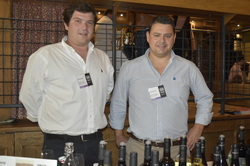 Carlos Queiros and Filipe Ferreira Carlos Queiros and Filipe Ferreira Quinta Da Foz also located in Porto and Douro was established in 1876 and one of the oldest producers in the Douro. I asked Carlos Queiros to select one wine for me to taste. He poured a Red Reserva 2011, a red blend of very old vineyards. Vinified in granite tanks, it is then aged for 18 months in French oak barrels. Although the tannins were “thick”, the fruit and smokiness came through. It is unfortunate that I didn’t have time to wait for it to open up. And speaking of time, I must end this post with the promise that I will continue tomorrow covering more regions and vineyards.
Saúde! Penina  It’s been a beautiful weekend. The weather, the foliage and company have been stellar. Apple picking, sight seeing and possibly one too many orchards were all part of the package. But the “holiday” isn’t over yet. The skies are blue and I’m off on another adventure. I’ll return on Wednesday with my take on “Wines of Portugal Showcase”.  And yes...I finally made the pumpkin muffins with pomegranate infused cranberries! Happy Monday!
Cheers! Penina  Friday was a warm but stormy day. Unfortunately, most of my afternoon business took place outside. At one point I was hoping to be transported to a tropical island with blue skies, sand and gentle surf. Didn’t happen. 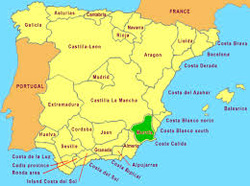 By the time evening rolled around I was happily transported to Jumilla, a wine DO title of Murcia that is a small region on the Mediterranean coast of southeastern Spain. It was about as close to water as I was going to get. 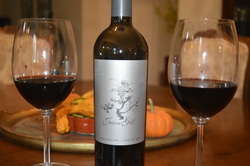 The wine we opened was a 2013 Bodegas de Juan Gil. The Monastrell grape (also known as Mourvedre grape) was hand picked from 40-year old parcels in their estate vineyards and kept in French oak barrels for 12 months. The color was dark red, bordering on purple. Aromas of ripe cherry, blackberry and herbs were dominant. The palate was layered with cherry, candy apple, licorice, plum and was quite succulent. As the wine opened over the course of an hour, cherry and pepper pushed it’s way forward with a hint of clove, leaving a much sweeter and jammy finish, along with soft tannins. http://bodegasjuangil.com/en/ It’s going to be a busy weekend filled with house guests and fun activities. And just maybe…I’ll squeeze in some time to make the pumpkin muffins!
Happy Saturday! Cheers! Penina 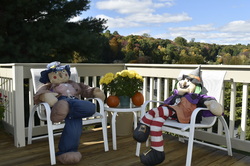 The weather has been beautiful for the past few days and I am enjoying the subtle changes of the foliage around me. And so are Ethel and Fred, long time friends that appear on my doorstep every fall season.  Being in a “fall” mood, I wanted to make my famous pumpkin muffins yesterday. But as usual, life got in the way. Perhaps I can make a batch in the next day or so. 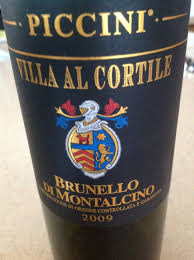 To celebrate my victorious “win” in court yesterday over an undeserved ticket, a friend and I went out to dinner. We dined at a local restaurant specializing in southern Italian cuisine. In addition to a superb dining experience, we drank a very nice wine. It was a 2009 Piccini Villa al Cortile Brunello di Montalcino, DOCG. The wine was 100% Sangiovese grape and dark ruby in color. A mosaic of aromas included blackberry, dark cherry, spices and herbs. The palate delivered licorice, dark berry, mushrooms and a hint of vanilla. As the wine opened, the flavors got more intense with a touch of tobacco on the finish. I found this to be a bold wine with round tannins. The wine was aged in oak for 26 months and is 14% alcohol. The Piccini family has been producing wines since 1882. http://www.tenutepiccini.it Enjoy this lovely Thursday!
Cheers! Penina |
Categories
All
|
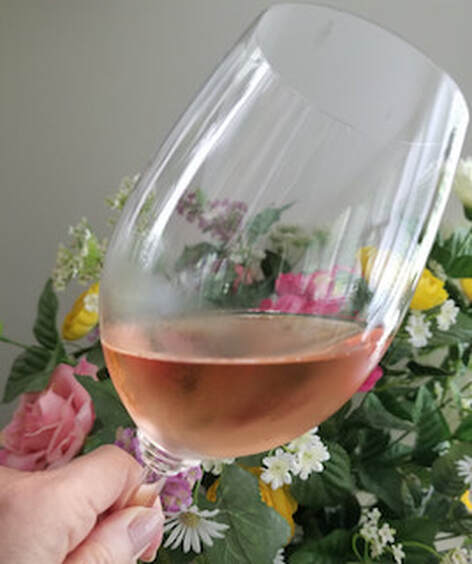
 RSS Feed
RSS Feed